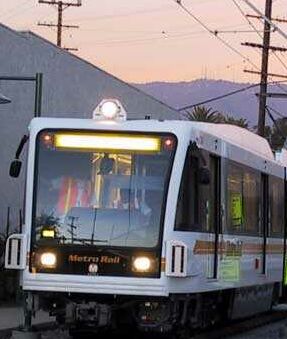
Light Rail Now can be contacted at: Light Rail Now |
Metropolitan Los Angeles is about to open a brand-new light rail transit (LRT) service – the Gold Line, constructed by the specially established Blue Line Construction Authority, and running from downtown LA's Union Station to the semi-suburban community of Pasadena. The Gold Line starter route (see map below), 13.7 miles long, traversing LA's Chinatown and various other neighborhoods and communities, has 13 stations, and is projected to initially carry at least 30,000 rider-trips a day. At Union Station, it will connect with both the existing Red Line metro as well as the Eastside LRT line, also under construction.
Costing some $725.5 million, or about $53 million per mile, including cars, shops, and substantial portions of elevated construction, the Gold Line has weathered fierce opposition, from Road Warriors and "BRT" enthusiasts to "Not in My Backyard" neighborhood critics who tried to force the project into costly tunnel construction, delaying the project by appealing to the California Public Utilities Commission (which ultimately ruled in favor of the construction authority). Now, as the news article below indicates, the first Gold Line starter route has been basically completed, and the system seems on schedule for startup this summer (2003).
San Gabriel Valley Tribune Gold Line builders claim 'substantial completion' met By Mary Bender It lacked the fanfare that will mark the Gold Line's opening day, but Friday nonetheless was significant for its builders the date they declared "substantial completion" of the light rail's construction. Although the project's loose ends won't be tied up until the Gold Line begins carrying paying passengers at a still-unannounced date this summer substantial completion is a project milestone for the Blue Line Construction Authority. The agency eventually will turn over ownership of the 13.7-mile light rail to the MTA, which will operate the Gold Line. The Gold Line's prime contractors, Kiewit-Washington, will be eligible for a $1 million bonus if they are found to have satisfactorily met Friday's substantial completion deadline. "They've been working 24 hours a day for the past week," said Rick Thorpe, chief executive officer of the Construction Authority. "We're waiting for documentation from the contractor, saying they made it. Then we'll have to evaluate it, to determine whether they made it," Thorpe said of the deadline. Despite the substantial completion threshold, Kiewit crews and Construction Authority personnel will continue working, reviewing and completing "punch list" items, like Gold Line signs along the route, Thorpe said. Rick Jager, a spokesman for the Metropolitan Transportation Authority, said the handoff of the Gold Line – a $725 million project – is an involved, incremental process, with plenty of paperwork for both sides to complete and documents to sign. The transfer of ownership must be registered with the county Recorder's Office, and the state Public Utilities Commission which regulates railroads must certify the Gold Line before it can begin operation, Jager said. "it's just like buying a house – you go through escrow,' Jager said. "A lot of things have to be done before the (Construction Authority) can say, 'Here, it's yours.'" One glitch the two agencies are addressing is a low-voltage problem with the light rail's overhead electrical lines, which power the trains, Jager said. Crews have traced the problem to two electrical substations, at Pasadena Avenue-Monterey Road in South Pasadena, and at the French Avenue Station in Los Angeles, Thorpe said. Gold Line trains run on 750 volts of electricity. Another problem surfaced May 3, when the Construction Authority held an event for all the workers who helped build the Gold Line. While giving full- route rides to 700 people aboard four trains that day, crossing gates got stuck for nearly an hour, blocking traffic at Mission Street and Meridian Avenue in South Pasadena. "That was the day it was raining. I think moisture got into one of the cabinets,' Thorpe said. "If a gate fails, it fails in the down position. It may be an annoyance, but it's a safety feature." There are 29 street-level rail crossings on the Los Angeles-to- Pasadena system. The crossing gate problem "didn't occur at all 29 locations. It just occurred at one," Thorpe said. "That's why we have all this (testing) to sort out all these problems before the public gets on." For the past month, the MTA has been conducting a variety of tests of the trains and track equipment. Starting Monday, they will simulate full passenger loads on the trains. "We're going to load up the trains with sandbags,' Jager said. Further, daily testing will run later until as late as 10 p.m.
"We're going to be operating the trains as if we've opened to the public, as though they're on a schedule," Jager said. That means trains will be running every 10 minutes during morning and evening rush hours, every 12 minutes during mid-day periods, and every 20 minutes during late-night hours. — Mary Bender can be reached at (626) 578-6300, Ext. 4456 or by e-mail at mary.schubert@sgvn.com.
Updated 2003/05/21 |
|
|
|